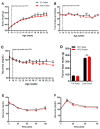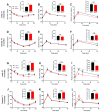Paternal High-Protein Diet Programs Offspring Insulin Sensitivity in a Sex-Specific Manner
- PMID: 34069853
- PMCID: PMC8157381
- DOI: 10.3390/biom11050751
Paternal High-Protein Diet Programs Offspring Insulin Sensitivity in a Sex-Specific Manner
Abstract
The impact of maternal nutrition on offspring is well documented. However, the implication of pre-conceptional paternal nutrition on the metabolic health of the progeny remains underexplored. Here, we investigated the impact of paternal high-protein diet (HPD, 43.2% protein) consumption on the endocrine pancreas and the metabolic phenotype of offspring. Male Wistar rats were given HPD or standard diet (SD, 18.9% protein) for two months. The progenies (F1) were studied at fetal stage and in adulthood. Body weight, glycemia, glucose tolerance (GT), glucose-induced insulin secretion in vivo (GIIS) and whole-body insulin sensitivity were assessed in male and female F1 offspring. Insulin sensitivity, GT and GIIS were similar between F1 females from HPD (HPD/F1) and SD fathers (SD/F1). Conversely, male HPD/F1 exhibited increased insulin sensitivity (p < 0.05) and decreased GIIS (p < 0.05) compared to male SD/F1. The improvement of insulin sensitivity in HPD/F1 was sustained even after 2 months of high-fat feeding. In male HPD/F1, the β cell mass was preserved and the β cell plasticity, following metabolic challenge, was enhanced compared to SD/F1. In conclusion, we provide the first evidence of a sex-specific impact of paternal HPD on the insulin sensitivity and GIIS of their descendants, demonstrating that changes in paternal nutrition alter the metabolic status of their progeny in adulthood.
Keywords: endocrine pancreas; glucose homeostasis; high-protein diet; insulin secretion; insulin sensitivity; paternal programming; sperm small non-coding RNAs.
Conflict of interest statement
The authors declare no conflict of interest associated with this manuscript.
Figures










Similar articles
-
Preconceptional exposure of adult male rats to bisphenol S impairs insulin sensitivity and glucose tolerance in their male offspring.Chemosphere. 2023 Feb;314:137691. doi: 10.1016/j.chemosphere.2022.137691. Epub 2022 Dec 30. Chemosphere. 2023. PMID: 36592828
-
Paternal high protein diet modulates body composition, insulin sensitivity, epigenetics, and gut microbiota intergenerationally in rats.FASEB J. 2021 Sep;35(9):e21847. doi: 10.1096/fj.202100198RR. FASEB J. 2021. PMID: 34405464
-
Maternal Roux-en-Y gastric bypass impairs insulin action and endocrine pancreatic function in male F1 offspring.Eur J Nutr. 2020 Apr;59(3):1067-1079. doi: 10.1007/s00394-019-01968-9. Epub 2019 Apr 13. Eur J Nutr. 2020. PMID: 30982179
-
Paternal effects on fetal programming.Anim Reprod. 2023 Aug 28;20(2):e20230076. doi: 10.1590/1984-3143-AR2023-0076. eCollection 2023. Anim Reprod. 2023. PMID: 37700908 Free PMC article. Review.
-
The POHaD paradigm: role of the placenta in paternal programming.Placenta. 2025 May 4:S0143-4004(25)00138-9. doi: 10.1016/j.placenta.2025.04.027. Online ahead of print. Placenta. 2025. PMID: 40350327 Review.
Cited by
-
Paternal impact on the developmental programming of sexual dimorphism.Front Cell Dev Biol. 2024 Dec 6;12:1520783. doi: 10.3389/fcell.2024.1520783. eCollection 2024. Front Cell Dev Biol. 2024. PMID: 39712575 Free PMC article. Review.
-
Small Noncoding RNAs in Reproduction and Infertility.Biomedicines. 2021 Dec 12;9(12):1884. doi: 10.3390/biomedicines9121884. Biomedicines. 2021. PMID: 34944700 Free PMC article. Review.
-
Paternal preconceptional diet enriched with n-3 polyunsaturated fatty acids affects offspring brain function in mice.Front Nutr. 2022 Oct 28;9:969848. doi: 10.3389/fnut.2022.969848. eCollection 2022. Front Nutr. 2022. PMID: 36386900 Free PMC article.
-
Intergenerational Inheritance of Hepatic Steatosis in a Mouse Model of Childhood Obesity: Potential Involvement of Germ-Line microRNAs.Nutrients. 2023 Mar 1;15(5):1241. doi: 10.3390/nu15051241. Nutrients. 2023. PMID: 36904241 Free PMC article.
-
N-acetyl-L-cysteine reduces testis ROS in obese fathers but fails in protecting offspring from acquisition of epigenetic traits at cyp19a1 and IGF11/H19 ICR loci.Front Cell Dev Biol. 2024 Oct 18;12:1450580. doi: 10.3389/fcell.2024.1450580. eCollection 2024. Front Cell Dev Biol. 2024. PMID: 39493346 Free PMC article.
References
-
- Dunford A.R., Sangster J.M. Maternal and Paternal Periconceptional Nutrition as an Indicator of Offspring Metabolic Syndrome Risk in Later Life through Epigenetic Imprinting: A Systematic Review. Diabetes Metab. Syndr. Clin. Res. Rev. 2017;11:S655–S662. doi: 10.1016/j.dsx.2017.04.021. - DOI - PubMed
Publication types
MeSH terms
Grants and funding
LinkOut - more resources
Full Text Sources
Medical
Molecular Biology Databases
Miscellaneous

